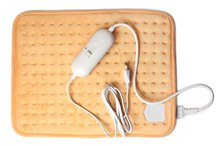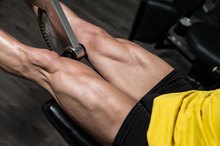A Knot in My Hamstring After a Pull
If you feel a knot in your hamstring after an injury, you likely have a good amount pain along with it. It's typically when you experience the most severe of hamstring injuries — a full tear — that a lump forms at the site. This is known as a grade III hamstring injury, and it requires immediate medical attention.
When this occurs, you've torn one of the three hamstring muscles or tendons — the biceps femoris is the most common muscle torn. It happens to be one of the most common injuries in the lower body, particularly for athletes playing football or soccer or running track. If you've injured your hamstring enough that you feel a lump or a knot in the area, you might need surgery or, at minimum, physical therapy.
Read more: Things to Do to Heal Sore Hamstrings
Getting Injured
When you place excessive force on your hamstrings — such as if you quickly start and stop moving or rapidly change direction — you're more likely to suffer a hamstring injury. It can also happen with a strong kick, like if you're playing soccer. If you haven't warmed up properly, the hamstring muscle is more likely to tear.
When it occurs, you might feel a sudden, sharp pain on the back of the thigh and feeling of a tear or a "pop" in the hamstring. Within hours, you might see bruising and swelling, including a knot or a lump where a tear occurred. Below that lump will likely be a depression or hole where the tear occurred.
Read more: Should You Stretch a Pulled Hamstring?
- When you place excessive force on your hamstrings — such as if you quickly start and stop moving or rapidly change direction — you're more likely to suffer a hamstring injury.
- When it occurs, you might feel a sudden, sharp pain on the back of the thigh and feeling of a tear or a "pop" in the hamstring.
Treating the Injury
Strain of the Pectoral Muscle
Learn More
If you're in a lot of pain, you should first see a doctor. If you have to wait for an appointment, get your rest on and skip walking, running and other activities that include moving your hamstring.
Additionally, ice the injury three to four times a day for 15 to 20 minutes at a time, wrapping an ice pack with a towel to provide a barrier between it and your skin. A compression wrap around the area with a knot can decreasing swelling and pain.
However, what you don't do is just as important. Avoid putting heat on the knot — at this point, you don't want to increase blood circulation to the area, as that will increase swelling. Additionally, don't do any massage on the area, whether yourself or by someone else.
- If you're in a lot of pain, you should first see a doctor.
- If you have to wait for an appointment, get your rest on and skip walking, running and other activities that include moving your hamstring.
Related Articles
References
- American Physical Therapy Association: Physical Therapist's Guide to Hamstring Injuries
- PhysioPrescription: Hamstring Injury Explained – Heal Fast and Strong!
- Ernlund L, Vieira LA. Hamstring injuries: update article. Rev Bras Ortop. 2017;52(4):373-382. doi:10.1016/j.rboe.2017.05.005
- Heiderscheit BC, Sherry MA, Silder A, Chumanov ES, Thelen DG. Hamstring strain injuries: recommendations for diagnosis, rehabilitation, and injury prevention. J Orthop Sports Phys Ther. 2010;40(2):67-81. doi:10.2519/jospt.2010.3047
- Moatshe G, Chahla J, Vap AR, et al. Repair of Proximal Hamstring Tears: A Surgical Technique. Arthrosc Tech. 2017;6(2):e311-e317. doi:10.1016/j.eats.2016.10.004
- Noonan TJ, Garrett WE. Muscle strain injury: diagnosis and treatment. J Am Acad Ortho Surg. Jul 1999;7:262-9.
Writer Bio
Greg Cooper began writing in 2007 with his book "The Reasonable Radical." He completed undergraduate work at West Virginia University and received his Doctor of Chiropractic from Sherman College. Cooper taught spinal manipulation in orthopedic hospitals in China and was part of a sports medicine team for the 1992 Olympic trials.








